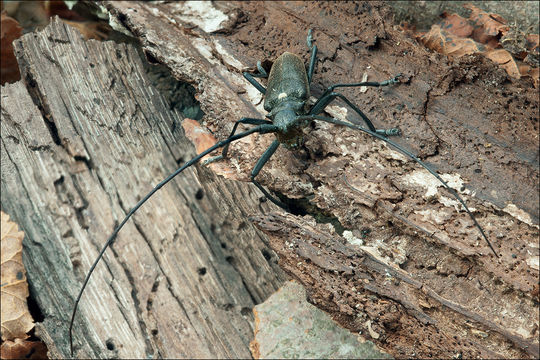Image of Cerambyx Longicorn

Description:
Slo.: strigo, hrastov kozliek - syn: Cerambyx longicorn - Habitat: mixed wood edge, Fagus sylvatica dominant, Picea abies, Ostrya carpinifolia, Fraxinus ornus, Corylus avellana frequent; found near woodshed of a cottage; slightly inclined mountain slope, southeast aspect, relatively dry and warm place; skeletal, calcareous ground, elevation 600 m (2.000 feet), average precipitations ~ 3.000 mm/year, average temperature 7-9 deg C, alpine phytogeographical region. Comment: The biggest bugs are often considered the worst bugs by some people. Others are capable to see beauty and incomprehensive imagination in them. Such is for me also Cerambyx cerdo. This beautiful beetle is one of the largest of the European species. It takes four years before such a beetle develops. It has very long thread-like antennae, in males significantly longer than their body. In females they are only as long as the elytra (hard wing cases). This beetle produces sounds - a chirping noise called stridulation. According to most sources this species develops only in oaks (genus Quercus), while in more southern parts of Europe it is also able to develop in the chestnuts (genus Castanea). However, Ref.3 states also other tree species as suitable. In fact there are neither oaks nor chestnuts known to me near the place where I found this male beetle and also not in the broader region of Lower Trenta valley. The Cerambyx cerdo is classified as vulnerable species on the IUCN Red List and also listed on Appendix II of the Bern Convention as a strictly protected fauna species. It is also protected according to Pravilnik o uvrstitvi ogroenih rastlinskih in ivalskih vrst v rdei seznam, Uradni list RS, t. 82/2002 (Regulation of enlisting of endangered plant and animal species onto Red List, Official Gazette of Republic Slovenia, no. 82/2002) (2002); prizadeta vrsta (E) (marked as a vulnerable species (E)). Ref.: (1) Fauna Europas, Bestimmungslexikon, George Westermann Velag, Brounschweig (1997), translated to Slovenian, Mladinaka Knjiga, Ljubljana (1981), pp xx (2) http://www.arkive.org/cerambyx-longicorn/cerambyx-cerdo/ (3) http://ec.europa.eu/environment/nature/natura2000/management/docs/Cerambyx%20cerdo%20factsheet%20-%20SWIFI.pdf
Included On The Following Pages:
- Life (creatures)
- Cellular (cellular organisms)
- Eukaryota (eukaryotes)
- Opisthokonta (opisthokonts)
- Metazoa (Animal)
- Bilateria
- Protostomia (protostomes)
- Ecdysozoa (ecdysozoans)
- Arthropoda (arthropods)
- Pancrustacea
- Hexapoda (hexapods)
- Insecta (insects)
- Pterygota (winged insects)
- Neoptera (neopteran)
- Endopterygota (endopterygotes)
- Coleoptera (beetles)
- Polyphaga
- Cucujiformia
- Cerambyx
- Cerambyx cerdo (Cerambyx Longicorn)
This image is not featured in any collections.
Source Information
- license
- cc-by-nc-sa-3.0
- copyright
- 2016 Dr. Amadej Trnkoczy
- photographer
- Dr. Amadej Trnkoczy
- original
- original media file
- visit source
- partner site
- CalPhotos
- ID


